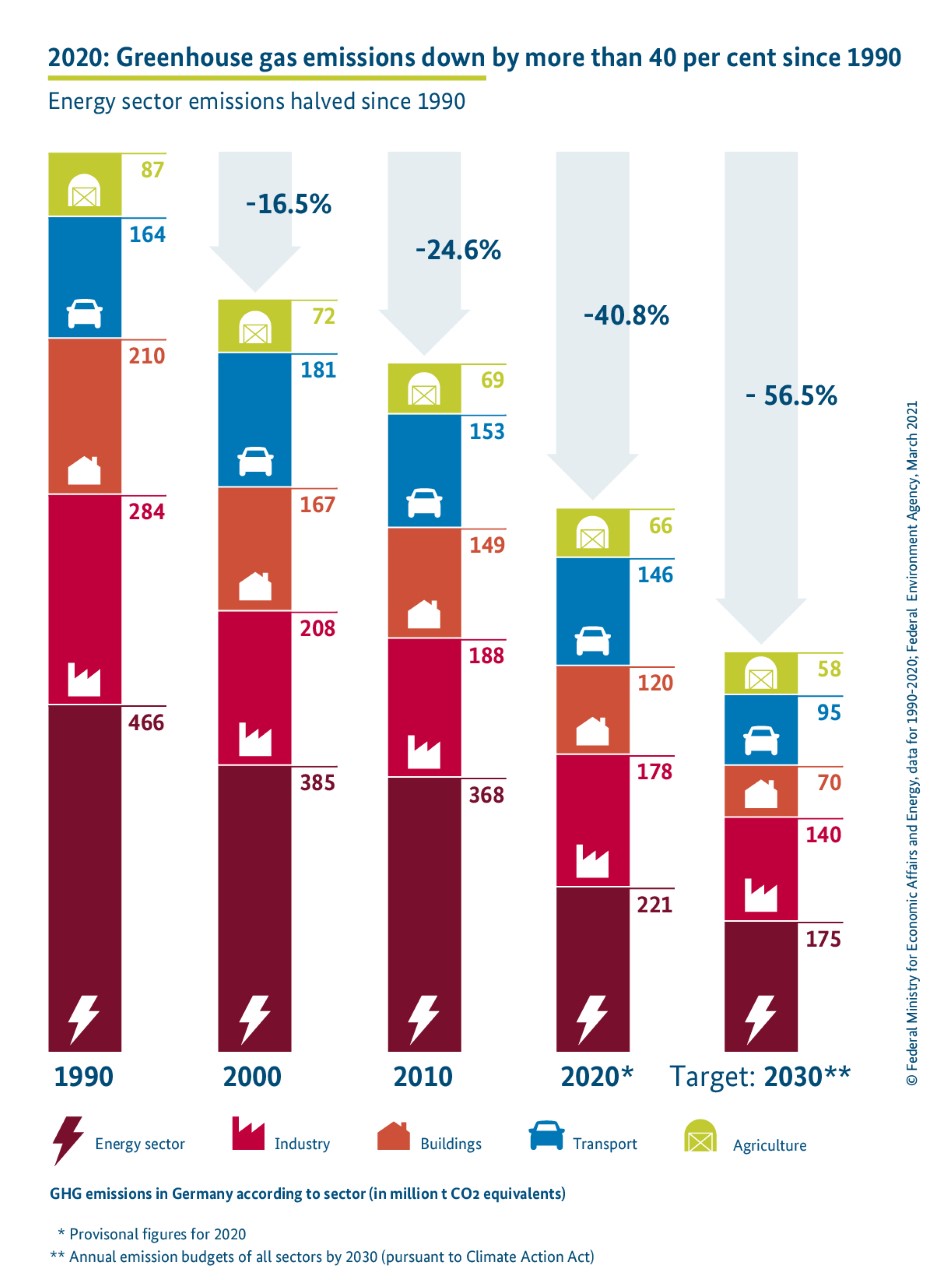Germany achieves 2020 climate target
Germany is making progress on climate action. In 2020, greenhouse gas emissions dropped by 40.8% compared to 1990, and by 8.7% compared to 2019. This is not only due to the coronavirus crisis, but also to a large extent to structural effects. In fact, there has been a significant and continuous decrease in greenhouse gas emissions since 2017.
 © Federal Ministry for Economic Affairs and Energy, data for 1990-2020; Federal Environment Agency, March 2021
© Federal Ministry for Economic Affairs and Energy, data for 1990-2020; Federal Environment Agency, March 2021
In the past three years alone, greenhouse gas emissions have dropped by 152 million tonnes, as suggested by the provisional emissions figures released by the Federal Environment Agency. This corresponds to a 17% reduction since 2017. The reduction is measured in CO2 equivalents (CO2eq), a unit of measurement used to compare the emissions of the seven different greenhouse gases based upon their global warming potential (there are six such gases in addition to CO2; more information from the Federal Environment Agency is available here, in German only) .
Energy sector makes biggest contribution to emissions reduction
In 2020, Germany released around 739 million tonnes of greenhouse gases into the atmosphere – roughly 70 million tonnes (or 8.7%) less than in 2019. For 2030, the goal is to achieve a 56.5% reduction in GHG emissions (compared to 1990 levels). Although the Federal Climate Action Act provides for a reduction of only at least 55% by 2030, the sum of binding sector-specific annual emission budgets by 2030 translates into a reduction rate of around 56.5%.
The energy sector made the biggest contribution to emissions reduction in 2020. In fact, it easily surpassed the specified targets by achieving a 53% GHG emissions reduction compared to 1990. This positive trend was mostly due to structural changes related to the transformation of the energy supply system, such as the decline of coal-fired power generation and the expansion of renewable energy. Electricity generation from hard coal declined markedly by 25% last year, while lignite-fired power generation saw a 19% decrease. This means that coal-fired electricity generation halved to only 135 TWh between 2015 and 2020. Meanwhile, the share of electricity consumption covered by renewable energy continued to rise in 2020, reaching around 45% according to provisional figures by the Working Group on Energy Balances.
Industrial sector meets 2020 target, with hopes pinned on hydrogen
The industrial sector, too, achieved its emissions reduction target for 2020. This is not only due to economic effects related to the coronavirus crisis, but also to structural factors including a functioning emissions trading system and improvements in efficiency. Further emissions reductions are expected from targeted incentives, financial support as well as long-term technological developments such as the use of hydrogen in industrial processes.
Buildings sector narrowly misses target, but is now benefiting from additional measures
The buildings sector, however, narrowly missed its 2020 target by a margin of two million tonnes. Still, the sector was to curb its emissions by an astonishing 42% compared with 1990 – when CO2 emissions had amounted to 210 million tonnes. The additional measures in the buildings sector met with a great response in 2020, but it will be a few years before emissions figures reflect their impact. The number of applications for the Economic Affairs Ministry’s building efficiency programmes almost doubled from 326,000 in 2019 to 600,000 in 2020. A particularly significant increase – from 76,000 in 2019 to over 280,000 in 2020 – was seen in the number of applications for the installation of heating systems based on renewable energies. The national emissions trading system that was introduced at the beginning of 2021 will allow the buildings sector to make further progress in reducing emissions.
Further information
- Press release by the Federal Ministry for Economic Affairs and Energy: Altmaier on 2020 climate target: 'Climate target for 2020 will be achieved. Energy sector makes biggest contribution' (in German only)
- Joint press release (Federal Ministry for the Environment/Federal Environment Agency): 'Germany's greenhouse gas emissions down 8.7 percent in 2020' (in German only)
- Federal Environment Agency: Greenhouse gas emissions in Germany 1990-2019, with provisional figures for 2020 (in German only)

